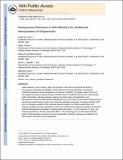Nanoporous Elements in Microfluidics for Multiscale Manipulation of Bioparticles
Author(s)
Chen, Grace D.; Fachin, Fabio; Fernandez-Suarez, Marta; Wardle, Brian L.; Toner, Mehmet
DownloadWardle_Nanoporous elements.pdf (2.671Mb)
OPEN_ACCESS_POLICY
Open Access Policy
Creative Commons Attribution-Noncommercial-Share Alike
Terms of use
Metadata
Show full item recordAbstract
Solid materials, such as silicon, glass, and polymers, dominate as structural elements in microsystems including microfluidics. Porous elements have been limited to membranes sandwiched between microchannel layers or polymer monoliths. This paper reports the use of micropatterned carbon-nanotube forests confined inside microfluidic channels for mechanically and/or chemically capturing particles ranging over three orders of magnitude in size. Nanoparticles below the internanotube spacing (80 nm) of the forest can penetrate inside the forest and interact with the large surface area created by individual nanotubes. For larger particles (>80 nm), the ultrahigh porosity of the nanotube elements reduces the fluid boundary layer and enhances particle–structure interactions on the outer surface of the patterned nanoporous elements. Specific biomolecular recognition is demonstrated using cells (≈10 μm), bacteria (≈1 μm), and viral-sized particles (≈40 nm) using both effects. This technology can provide unprecedented control of bioseparation processes to access bioparticles of interest, opening new pathways for both research and point-of-care diagnostics.
Description
Author Manuscript 2011 July 22
Date issued
2011-03Department
Massachusetts Institute of Technology. Department of Aeronautics and AstronauticsJournal
Small
Publisher
Wiley Blackwell
Citation
Chen, Grace D., Fabio Fachin, Marta Fernandez-Suarez, Brian L. Wardle, and Mehmet Toner. “Nanoporous Elements in Microfluidics for Multiscale Manipulation of Bioparticles.” Small 7, no. 8 (April 18, 2011): 1061-1067.
Version: Author's final manuscript
ISSN
16136810
1613-6829